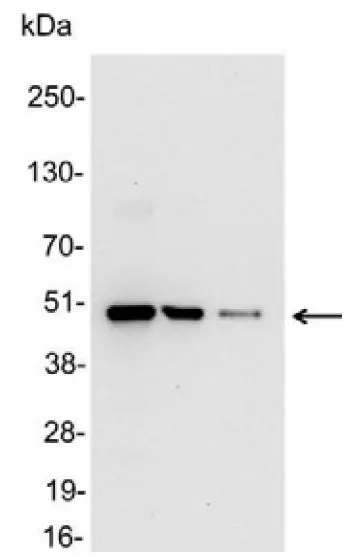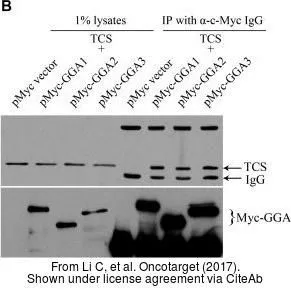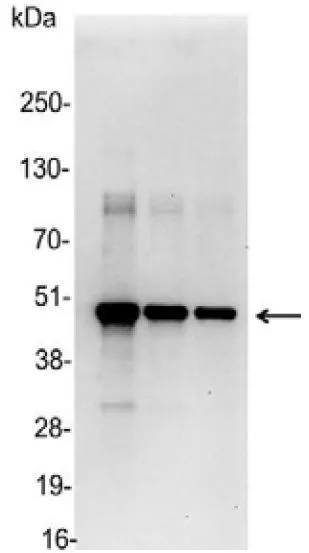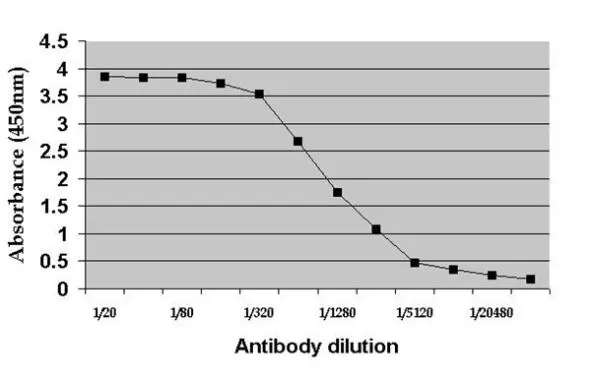c-Myc antibody
GTX20056
ApplicationsImmunoFluorescence, ImmunoPrecipitation, Western Blot, ChIP Chromatin ImmunoPrecipitation, ELISA, ImmunoCytoChemistry, ImmunoHistoChemistry, ImmunoHistoChemistry Frozen, ImmunoHistoChemistry Paraffin
Product group Antibodies
TargetMYC
Overview
- SupplierGeneTex
- Product Namec-Myc antibody [9E11]
- Delivery Days Customer9
- Application Supplier NoteSuggested working dilutions: Immunoprecipitation: 2 microg/mg protein lysate Western blotting: 1:500-1:1000. Optimal dilutions/concentrations should be determined by the end user
- ApplicationsImmunoFluorescence, ImmunoPrecipitation, Western Blot, ChIP Chromatin ImmunoPrecipitation, ELISA, ImmunoCytoChemistry, ImmunoHistoChemistry, ImmunoHistoChemistry Frozen, ImmunoHistoChemistry Paraffin
- CertificationResearch Use Only
- ClonalityMonoclonal
- Concentration0.7 mg/ml
- ConjugateUnconjugated
- Gene ID4609
- Target nameMYC
- Target descriptionMYC proto-oncogene, bHLH transcription factor
- Target synonymsMRTL, MYCC, bHLHe39, c-Myc, myc proto-oncogene protein, avian myelocytomatosis viral oncogene homolog, class E basic helix-loop-helix protein 39, myc-related translation/localization regulatory factor, proto-oncogene c-Myc, transcription factor p64, v-myc avian myelocytomatosis viral oncogene homolog, v-myc myelocytomatosis viral oncogene homolog
- HostMouse
- IsotypeIgG2a
- Protein IDP01106
- Protein NameMyc proto-oncogene protein
- Scientific DescriptionThis gene is a proto-oncogene and encodes a nuclear phosphoprotein that plays a role in cell cycle progression, apoptosis and cellular transformation. The encoded protein forms a heterodimer with the related transcription factor MAX. This complex binds to the E box DNA consensus sequence and regulates the transcription of specific target genes. Amplification of this gene is frequently observed in numerous human cancers. Translocations involving this gene are associated with Burkitt lymphoma and multiple myeloma in human patients. There is evidence to show that translation initiates both from an upstream, in-frame non-AUG (CUG) and a downstream AUG start site, resulting in the production of two isoforms with distinct N-termini. [provided by RefSeq, Aug 2017]
- Storage Instruction-20°C or -80°C,2°C to 8°C
- UNSPSC12352203
References
- Interferon-induced transmembrane protein 3 is a type II transmembrane protein. Bailey CC et al., 2013 Nov 8, J Biol ChemRead more
- Regulation of the yeast Ace2 transcription factor during the cell cycle. Sbia M et al., 2008 Apr 25, J Biol ChemRead more
- Dephosphorylation and genome-wide association of Maf1 with Pol III-transcribed genes during repression. Roberts DN et al., 2006 Jun 9, Mol CellRead more
- High functional overlap between MluI cell-cycle box binding factor and Swi4/6 cell-cycle box binding factor in the G1/S transcriptional program in Saccharomyces cerevisiae. Bean JM et al., 2005 Sep, GeneticsRead more
- Interaction of the S-phase cyclin Clb5 with an RXL docking sequence in the initiator protein Orc6 provides an origin-localized replication control switch. Wilmes GM et al., 2004 May 1, Genes DevRead more







![FACS analysis of transfected LST-1-c-Myc in HEK-293 cells (red) compared with non-transfected HEK-293 cells (blue) using GTX10826 c-Myc antibody [9E10] (FITC).](https://www.genetex.com/upload/website/prouct_img/normal/GTX10826/GTX10826_20191025_AP_006_112_w_23060120_166.webp)
